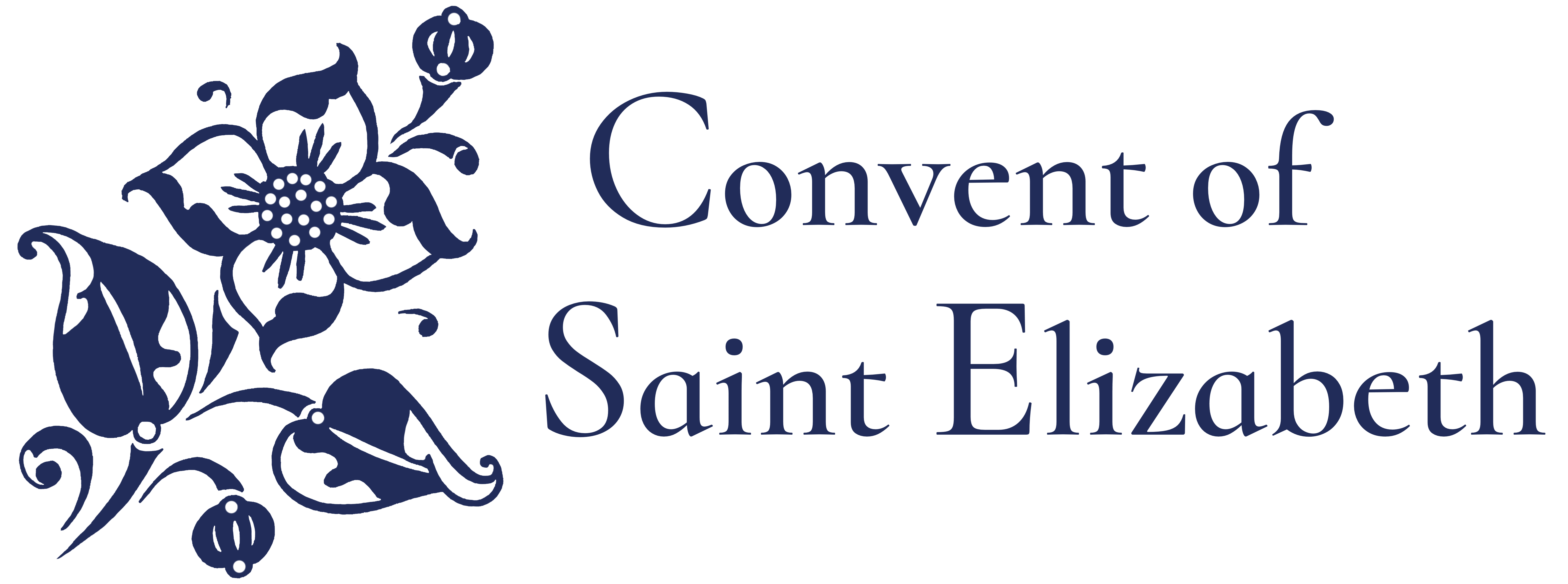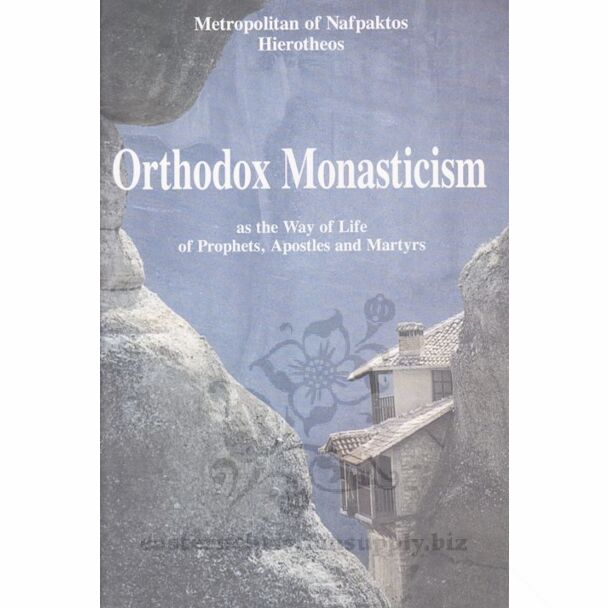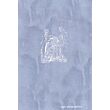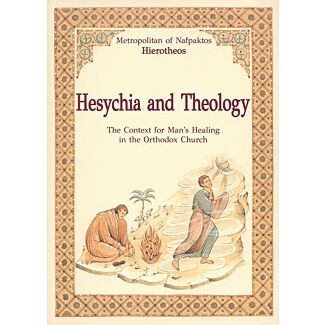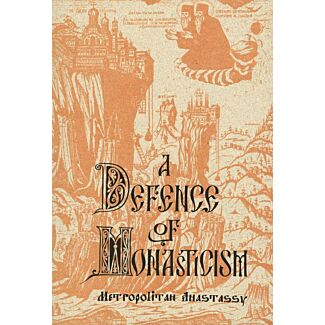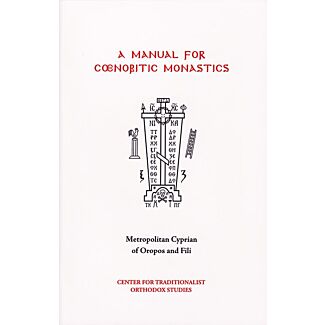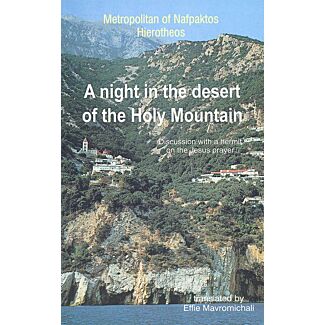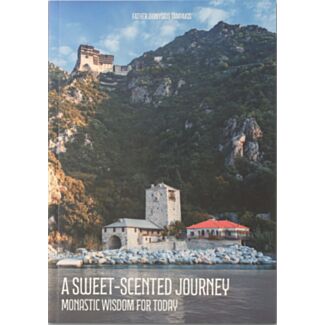Orthodox Monasticism as the Way of Life of Prophets, Apostles and Martyrs
Metropolitan of Nafpaktos Hierotheos
Publication Data: Levadia, Greece: Birth of the Theotokos Monastery, 2011
Format: softcover
Number of Pages: 508
Dimensions (l × w × h): 20.8 cm × 14.0 cm × 3.0 cm
ISBN: 978‒960‒7070‒73‒9
Metropolitan of Nafpaktos Hierotheos
“The monastic life is the Christian life, the way of life of Prophets, Apostles and Martyrs. In reality it is the evangelical life, as a life of repentance and keeping Christ’s commandments to as perfect a degree as possible. Christ taught this life in the Sermon on the Mount, in the exhortations to be vigilant and take heed, to have absolute faith in God, to avoid cares that cause anxiety, and so on (Matt. ch. 5 ff.). He often went up the mountain to pray on His own (Matt. 14:23, Mark 6:46, John 6:15), not because He needed to, but to teach us this way of life. He Himself urged us to pray in the ‘inner chamber’, and when we have shut the door, to pray to our Father ‘Who is in secret’ (Matt. 6:6). [...]Unfortunately the world has a different opinion of monasticism, that it is a distortion of Christianity or subject to influences outside the Christian world. In the West, too, monasticism was rejected, either because it was ill-treated by various ideologies or banished from the life of the Christian confessions. Monastic life, however, is the way of life of the Prophets, Apostles and Martyrs, as described in this book.”
—“Preface by the Author to the English Edition”
CONTENTS
Preface to the English Edition
Introduction to the Greek Edition
Part 1
Orthodox Hesychastic Monasticism
1. Orthodox Monasticism
a) Monasticism as the Way of Life of Prophets, Apostles and Martyrs
b) Monasticism and Christ’s Commandments
c) Monasticism and Healing
d) Three Renunciations, Three Crosses and Three Births
e) The Three Monastic Virtues
f) Monasticism and “Dogmatic Consciousness”
g) Monks and Bishops
h) Hesychia and Mission
i) The Monastic Life as an Angelic Life
j) The Solitary Way of Life - “Monadikē Politeia”
h) The Timeliness of Orthodox Monasticism
2. Characteristics of Orthodox Monks
3. The Spirit of Orthodox Monasticism
4. Orthodox Asceticism
5. The Monk’s Spiritual Reference Points
6. Monasticism and Theology
7. Addresses at Rasophorias and Tonsures
a) The Vocation to the Monastic Life
b) Changing Name
c) The Monastic Life as Birth in Christ
d) Death and Birth in the Monastic Life
e) The Spiritual Arena
f) Monks as Followers of the Lamb
g) The Cross in the Monastic Life
h) The Monk and the World
i) The Sayings of the Fathers in the Gerontikon
j) Love, Virginity and Theology
8. The Role of the Abbot in the Monastery and the Church
Part 2
Monasticism on Mount Athos and Mount Sinai
Introduction
A Monasticism on Mount Athos
1. The Mystery of the Mother of God and the Mystery of Mount Athos
a) Her Living Presence
b) The Mother of God’s Promise
c) The Mystery of Self-Emptying and Deification
2. The Holy Mountain and Its Significance
3. Humble Pilgrims on the Holy Mountain
a) The Abbot’s Address
b) My Reply (cassette recording)
4. Faith and Love - an Expression of Monasticism as Martyrdom
5. The Holy Mother of God and Romanity
6. The Living Ark of God
7. With the Athonite Fathers
8. The Holy Mountain as the Living Golgotha and All-Holy Tomb
9. Two Monks from the Monastery of Dionysiou
10. Life in the Skete
11. Monastic Wisdom: The Letters of Elder Joseph the Hesychast
12. Father Ephraim of Katounakia
13. Counsels from the Holy Mountain
14. The Mystery of Man and the Mystery of the Church
B Hesychasm on Mount Sinai
The Ascetic Life and Mystical Theology in the Region of Mount Sinai
1. Moses as a Prototype of Spiritual Perfection
2. The Fathers of Sinai as Bearers of the Orthodox Tradition
3. Hesychasm on Mount Sinai
a) St John Climacus
b) St Gregory of Sinai
Part 3
The Mystery of the Cross in the Monastic Life
1. The Hesychastic Monasticism of St Basil the Great
a) St Basil the Great as an Ascetic
b) The Ascetic Life According to St Basil the Great
1) The Essence and Purpose of the Monastic Life
2) Renunciation
3) Obedience to the Abbot of the Monastery
4) Asceticism in Christ
5) The Neptic and Hesychastic Life
6) The Cenobitic Life
7) Contact with the World
8) Women’s Monasticism
9) The Longer Rules and The Shorter Rules
10) Conclusion
2. The Theology of Elder Sophrony
3. The Mystery of the Cross in the Teaching of the Apostle Paul in Relation to the Experience of Elder Sophrony
a) The Mystery of the Cross According to St Isaac the Syrian and St Gregory Palamas
b) The Mystery of the Cross According to the Apostle Paul
c) Elder Sophrony’s Personal Participation in the Mystery of the Cross
Concluding Remarks
Part 4
Orthodox Monasticism and Its Secularisation
Orthodox Monasticism and Its Secularisation
1. Monasticism as the Life of Prophets, Apostles and Martyrs
a) Apostolic Texts as the Basis for Monasticism
b) Secularisation as a Distortion of the Life of Prophets, Apostles and Martyrs
c) Monasticism as a Reaction to the Spirit of Secularisation
2. Monasticism According to St Symeon the New Theologian
a) The True Monk
b) Prerequisites for True Monasticism
c) The Secularisation of Monasticism
3. The State of Orthodox Monasticism Today
a) Traditional Monasticism According to St Symeon of Thessaloniki
b) Western Monasticism - The Monastic Orders of
the West
c) The Westernisation of Orthodox Monasticism
d) The Position of the Bishop in the Church According to St Symeon of Thessaloniki
Concluding Remarks
Part 5
The Canonical Structure of Monasticism and the Service of Tonsure
1. Monks and the Sacred Canons
2. Orthodox Monasticism According to the Service of the Great and Angelic Schema
a) Professions and Promises
b) Catechism and Profession
c) Three Prayers
d) Actions and Symbolism
Format: softcover
Number of Pages: 508
Dimensions (l × w × h): 20.8 cm × 14.0 cm × 3.0 cm
ISBN: 978‒960‒7070‒73‒9
Metropolitan of Nafpaktos Hierotheos
“The monastic life is the Christian life, the way of life of Prophets, Apostles and Martyrs. In reality it is the evangelical life, as a life of repentance and keeping Christ’s commandments to as perfect a degree as possible. Christ taught this life in the Sermon on the Mount, in the exhortations to be vigilant and take heed, to have absolute faith in God, to avoid cares that cause anxiety, and so on (Matt. ch. 5 ff.). He often went up the mountain to pray on His own (Matt. 14:23, Mark 6:46, John 6:15), not because He needed to, but to teach us this way of life. He Himself urged us to pray in the ‘inner chamber’, and when we have shut the door, to pray to our Father ‘Who is in secret’ (Matt. 6:6). [...]Unfortunately the world has a different opinion of monasticism, that it is a distortion of Christianity or subject to influences outside the Christian world. In the West, too, monasticism was rejected, either because it was ill-treated by various ideologies or banished from the life of the Christian confessions. Monastic life, however, is the way of life of the Prophets, Apostles and Martyrs, as described in this book.”
—“Preface by the Author to the English Edition”
CONTENTS
Preface to the English Edition
Introduction to the Greek Edition
Part 1
Orthodox Hesychastic Monasticism
1. Orthodox Monasticism
a) Monasticism as the Way of Life of Prophets, Apostles and Martyrs
b) Monasticism and Christ’s Commandments
c) Monasticism and Healing
d) Three Renunciations, Three Crosses and Three Births
e) The Three Monastic Virtues
f) Monasticism and “Dogmatic Consciousness”
g) Monks and Bishops
h) Hesychia and Mission
i) The Monastic Life as an Angelic Life
j) The Solitary Way of Life - “Monadikē Politeia”
h) The Timeliness of Orthodox Monasticism
2. Characteristics of Orthodox Monks
3. The Spirit of Orthodox Monasticism
4. Orthodox Asceticism
5. The Monk’s Spiritual Reference Points
6. Monasticism and Theology
7. Addresses at Rasophorias and Tonsures
a) The Vocation to the Monastic Life
b) Changing Name
c) The Monastic Life as Birth in Christ
d) Death and Birth in the Monastic Life
e) The Spiritual Arena
f) Monks as Followers of the Lamb
g) The Cross in the Monastic Life
h) The Monk and the World
i) The Sayings of the Fathers in the Gerontikon
j) Love, Virginity and Theology
8. The Role of the Abbot in the Monastery and the Church
Part 2
Monasticism on Mount Athos and Mount Sinai
Introduction
A Monasticism on Mount Athos
1. The Mystery of the Mother of God and the Mystery of Mount Athos
a) Her Living Presence
b) The Mother of God’s Promise
c) The Mystery of Self-Emptying and Deification
2. The Holy Mountain and Its Significance
3. Humble Pilgrims on the Holy Mountain
a) The Abbot’s Address
b) My Reply (cassette recording)
4. Faith and Love - an Expression of Monasticism as Martyrdom
5. The Holy Mother of God and Romanity
6. The Living Ark of God
7. With the Athonite Fathers
8. The Holy Mountain as the Living Golgotha and All-Holy Tomb
9. Two Monks from the Monastery of Dionysiou
10. Life in the Skete
11. Monastic Wisdom: The Letters of Elder Joseph the Hesychast
12. Father Ephraim of Katounakia
13. Counsels from the Holy Mountain
14. The Mystery of Man and the Mystery of the Church
B Hesychasm on Mount Sinai
The Ascetic Life and Mystical Theology in the Region of Mount Sinai
1. Moses as a Prototype of Spiritual Perfection
2. The Fathers of Sinai as Bearers of the Orthodox Tradition
3. Hesychasm on Mount Sinai
a) St John Climacus
b) St Gregory of Sinai
Part 3
The Mystery of the Cross in the Monastic Life
1. The Hesychastic Monasticism of St Basil the Great
a) St Basil the Great as an Ascetic
b) The Ascetic Life According to St Basil the Great
1) The Essence and Purpose of the Monastic Life
2) Renunciation
3) Obedience to the Abbot of the Monastery
4) Asceticism in Christ
5) The Neptic and Hesychastic Life
6) The Cenobitic Life
7) Contact with the World
8) Women’s Monasticism
9) The Longer Rules and The Shorter Rules
10) Conclusion
2. The Theology of Elder Sophrony
3. The Mystery of the Cross in the Teaching of the Apostle Paul in Relation to the Experience of Elder Sophrony
a) The Mystery of the Cross According to St Isaac the Syrian and St Gregory Palamas
b) The Mystery of the Cross According to the Apostle Paul
c) Elder Sophrony’s Personal Participation in the Mystery of the Cross
Concluding Remarks
Part 4
Orthodox Monasticism and Its Secularisation
Orthodox Monasticism and Its Secularisation
1. Monasticism as the Life of Prophets, Apostles and Martyrs
a) Apostolic Texts as the Basis for Monasticism
b) Secularisation as a Distortion of the Life of Prophets, Apostles and Martyrs
c) Monasticism as a Reaction to the Spirit of Secularisation
2. Monasticism According to St Symeon the New Theologian
a) The True Monk
b) Prerequisites for True Monasticism
c) The Secularisation of Monasticism
3. The State of Orthodox Monasticism Today
a) Traditional Monasticism According to St Symeon of Thessaloniki
b) Western Monasticism - The Monastic Orders of
the West
c) The Westernisation of Orthodox Monasticism
d) The Position of the Bishop in the Church According to St Symeon of Thessaloniki
Concluding Remarks
Part 5
The Canonical Structure of Monasticism and the Service of Tonsure
1. Monks and the Sacred Canons
2. Orthodox Monasticism According to the Service of the Great and Angelic Schema
a) Professions and Promises
b) Catechism and Profession
c) Three Prayers
d) Actions and Symbolism
Write Your Own Review
Frequently Bought Together
-
This Item:
$50.95
-
Hesychia and Theology: The Context for Man’s Healing in the Orthodox Church
$48.95
-
A Defence of Monasticism
$20.00
-
A Manual for Cœnobitic Monastics
$4.95
-
A Night in the Desert of the Holy Mountain: Discussion with a Hermit on the Jesus Prayer
$29.00
-
A Sweet-Scented Journey: Monastic Wisdom for Today
$26.00
Total price


